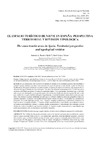Identificador persistente para citar o vincular este elemento:
https://accedacris.ulpgc.es/jspui/handle/10553/70456
| Campo DC | Valor | idioma |
|---|---|---|
| dc.contributor.author | Ramón Ojeda, Antonio Ángel | en_US |
| dc.contributor.author | López Rivero, Sarah | en_US |
| dc.date.accessioned | 2020-02-21T12:48:53Z | - |
| dc.date.available | 2020-02-21T12:48:53Z | - |
| dc.date.issued | 2019 | en_US |
| dc.identifier.issn | 0373-2568 | en_US |
| dc.identifier.uri | https://accedacris.ulpgc.es/handle/10553/70456 | - |
| dc.description.abstract | Las instalaciones para la práctica de deportes de invierno en las montañas españolas han contribuido a producir espacios turísticos asociados a las estaciones de esquí. El presente estudio aborda, a partir de diferentes clasificaciones del espacio turístico de montaña asociado a la práctica de deportes de invierno, una propuesta de clasificación del espacio turístico de nieve en España. Para ello se ha elaborado un inventario de las 33 estaciones pertenecientes a ATUDEM que incluye 28 centros de modalidad alpina y 5 de esquí nórdico. En primer lugar, se ha realizado una revisión bibliográfica, con especial atención a los intentos de clasificación de estos espacios llevados a cabo en el ámbito de los Alpes y también en España. Seguidamente, a partir del inventario extenso de las estaciones españolas y tras elaborar esquemas territoriales de cada caso con el fin de estudiar las relaciones geográficas entre componentes espaciales, se propone una clasificación del espacio turístico de nieve y se describen sus características principales. Las cuatro tipologías posibles son: 1. Espacios complejos polinucleares y polivalentes. Estaciones de esquí asociadas a complejos turísticos. 2. Espacios simples mononucleares y especializados que conforman estaciones aisladas con urbanización turística. 3. Espacios simples mononucleares y especializados que conforman estación aislada más hotel o inmueble de apartamentos turísticos. 4. Espacios simples mononucleares y especializados que conforman estación aislada sin alojamientos en el ámbito inmediato. | en_US |
| dc.description.abstract | The facilities for the practice of winter sports in the Spanish mountains have contributed to produce touristic spaces associated with ski resorts. The current study approaches, from the different mountain’s classifications, touristic space combined with the practice of winter sports, a proposal of classification of the touristic snow area in Spain. For this purpose, an inventory of the 33 stations belonging to ATUDEM has been drawn up, which includes 28 alpine and 5 Nordic ski centers. First of all, a bibliographic review was carried out with special attention to the attempts to classify these spaces carried out in the area of the Alps and also in Spain. From the extensive inventory of Spanish stations and after developing territorial diagrams for each case in order to study the geographical relationships between spatial components, a classification of the snow tourism space is proposed, and its main characteristics are described. The four possible typologies are: 1. Multi-nuclear and polyvalent complex spaces. Ski resorts associated with tourist complexes, 2. Mononuclear and specialized single spaces that make up isolated ski resorts with tourist urbanization. 3. Mononuclear and specialized single spaces that make up isolated ski resort with hotel or tourist apartments and 4. Mononuclear and specialized single spaces that make up an isolated ski resort without accommodation in the immediate area. | en_US |
| dc.language | spa | en_US |
| dc.relation.ispartof | Pirineos | en_US |
| dc.source | Pirineos [ISSN 0373-2568], n. 174, p. 46 | en_US |
| dc.subject | 5401 Geografía económica | en_US |
| dc.subject | 531290 Economía sectorial: turismo | en_US |
| dc.subject.other | Estación de esquí | en_US |
| dc.subject.other | Espacio turístico de nieve | en_US |
| dc.subject.other | Área de influencia | en_US |
| dc.subject.other | Propuesta de clasificación | en_US |
| dc.title | El espacio turístico de nieve en España. Perspectiva territorial y revisión tipológica | en_US |
| dc.title.alternative | The snow tourist areas in Spain. Territorial perspective and typological revision | en_US |
| dc.type | info:eu-repo/semantics/article | en_US |
| dc.type | Article | en_US |
| dc.identifier.doi | 10.3989/pirineos.2019.174006 | en_US |
| dc.identifier.scopus | 2-s2.0-85073654936 | - |
| dc.contributor.orcid | #NODATA# | - |
| dc.contributor.orcid | #NODATA# | - |
| dc.description.firstpage | 046 | - |
| dc.relation.volume | 174 | - |
| dc.investigacion | Artes y Humanidades | en_US |
| dc.type2 | Artículo | en_US |
| dc.utils.revision | Sí | en_US |
| dc.identifier.ulpgc | Sí | es |
| dc.description.sjr | 0,269 | |
| dc.description.sjrq | Q3 | |
| item.grantfulltext | open | - |
| item.fulltext | Con texto completo | - |
| crisitem.author.dept | GIR IATEXT: Sociedades y Espacios Atlánticos | - |
| crisitem.author.dept | IU de Análisis y Aplicaciones Textuales | - |
| crisitem.author.dept | Departamento de Geografía | - |
| crisitem.author.orcid | 0000-0002-4578-5185 | - |
| crisitem.author.parentorg | IU de Análisis y Aplicaciones Textuales | - |
| crisitem.author.fullName | Ramón Ojeda, Antonio Ángel | - |
| Colección: | Artículos | |
Citas SCOPUSTM
1
actualizado el 08-jun-2025
Visitas
381
actualizado el 15-mar-2025
Descargas
398
actualizado el 15-mar-2025
Google ScholarTM
Verifica
Altmetric
Comparte
Exporta metadatos
Los elementos en ULPGC accedaCRIS están protegidos por derechos de autor con todos los derechos reservados, a menos que se indique lo contrario.
